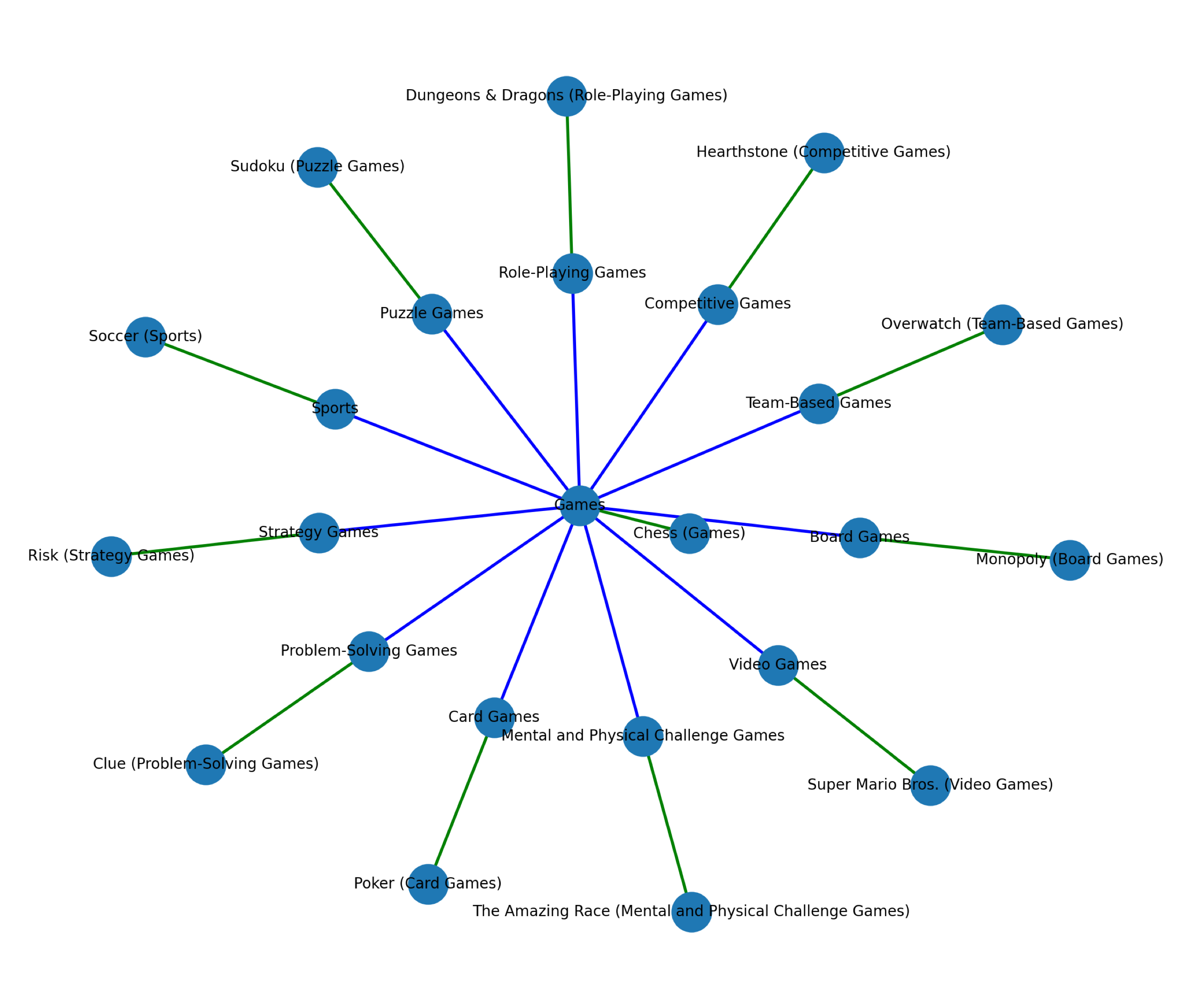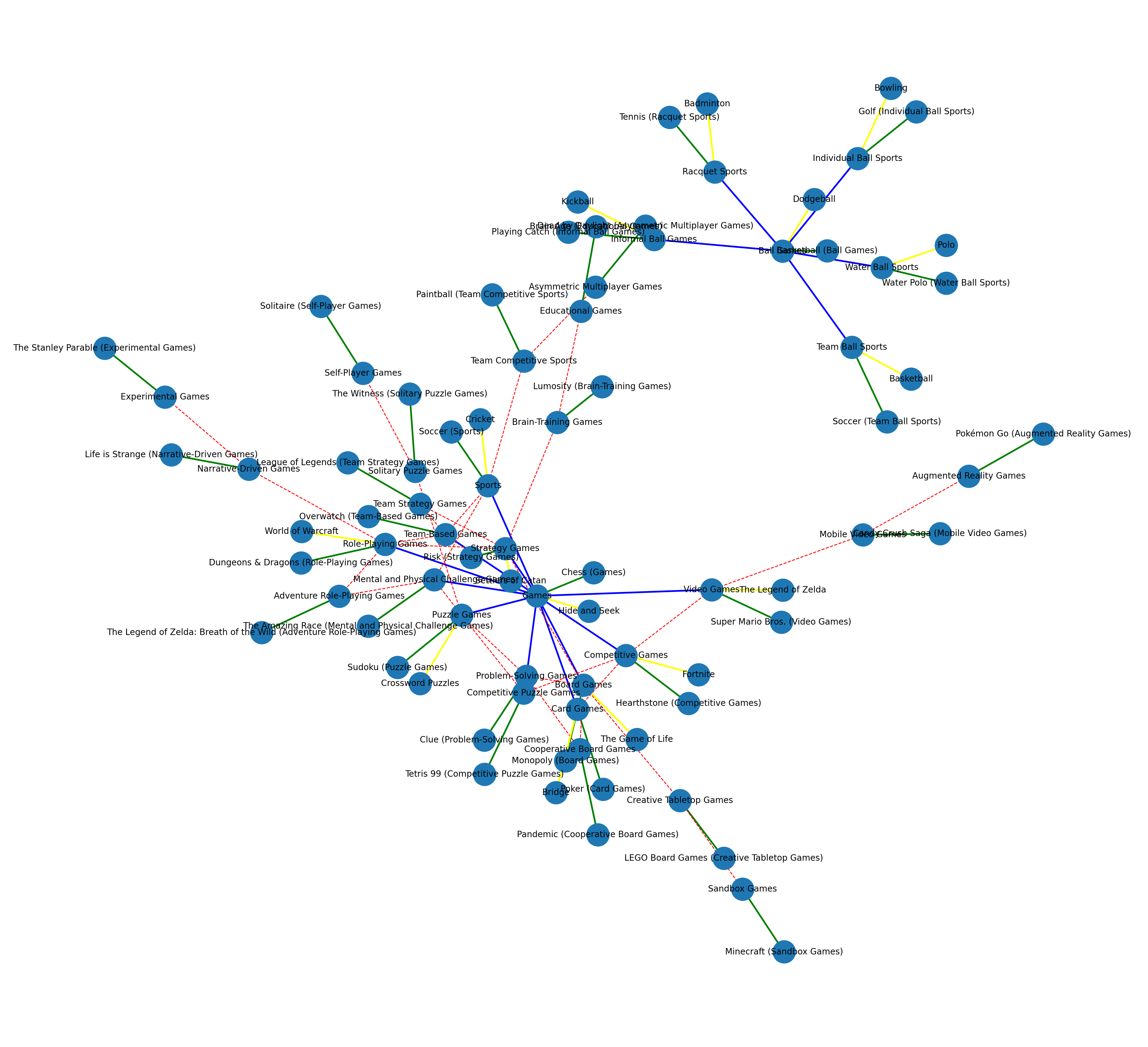What are associations?
Prototype theory (wiki):
A model for graded categorization in cognitive science.
In this prototype theory, any given concept in any given language has a real world example that best represents this concept.
Based on the notion of family resemblance from Wittgenstein.
It can be implemented using GPT-4
- we use the classic games example from Wittgenstein.
- See the famous quote attributed to him:
Consider for example the proceedings that we call ‘games’. I mean board games, card games, ball games, Olympic games, and so on. What is common to them all? Don’t say, “There must be something common, or they would not be called ‘games’“—but look and see whether there is anything common to all. For if you look at them you will not see something common to all, but similarities, relationships, and a whole series of them at that. To repeat: don’t think, but look! Look for example at board games, with their multifarious relationships. Now pass to card games; here you find many correspondences with the first group, but many common features drop out, and others appear. When we pass next to ball games, much that is common is retained, but much is lost. Are they all ‘amusing’? Compare chess with noughts and crosses. Or is there always winning and losing, or competition between players? Think of patience. In ball games there is winning and losing; but when a child throws his ball at the wall and catches it again, this feature has disappeared. Look at the parts played by skill and luck; and at the difference between skill in chess and skill in tennis. Think now of games like ring-a-ring-a-roses; here is the element of amusement, but how many other characteristic features have disappeared! And we can go through the many, many other groups of games in the same way; can see how similarities crop up and disappear. And the result of this examination is: we see a complicated network of similarities overlapping and criss-crossing: sometimes overall similarities, sometimes similarities of detail.
Wittgenstein, Ludwig (1953). Philosophical Investigations. Blackwell Publishing.
Diagram generated by a “Data Analyst” GPT-4 model:

In the GPT-inspired approach, we use GPT to create pairs of categories and prototypes of games, such as Games -> Chess, Team-Based Games -> Overwatch, and so on. We see some similarities mapped by way of the red dashed lines that show for example “Competitive Games -> Hearthstone” as a common feature of Video Games and Card Games (A competitive online card game).
We then go on to show chains of association between two category nodes (like Card Games to Video Games). We ask GPT to consider pairs and then synthesize a common category:
- From Card Games to Video Games
- Category: Competitive Games
- Prototype: Hearthstone (a digital card game)
- Connection: Combines the card-playing aspect of “Poker” with the digital, competitive nature of video games like “Super Mario Bros.”
Thus these categories are interpolated connections that sit between categories. What are they? Not exactly sub categories of their links, but ones that combine aspects of both of their neighbors. Thus we’re understanding how concepts like “card-games” can be understood in terms of their prototypes “poker” as well as “video games” being understood in terms of its “digital, competitive nature” of the prototype “Super Mario Bros”. We see it create these kinds of interpolated categories for a few other examples:
-
From Board Games to Role-Playing Games
- Category: Strategy Games
- Prototype: Risk (a strategic board game)
- Connection: Links the strategic elements of board games like “Monopoly” to the strategic planning in role-playing games like “Dungeons & Dragons.”
-
From Sports to Puzzle Games
- Category: Mental and Physical Challenge Games
- Prototype: The Amazing Race (a reality competition show)
- Connection: Bridges the physical competitiveness of sports like “Soccer” with the mental challenges presented in puzzle games like “Sudoku.”
-
From Role-Playing Games to Sports
- Category: Team-Based Games
- Prototype: Overwatch (a team-based multiplayer video game)
- Connection: Connects the collaborative, team-focused aspects of RPGs like “Dungeons & Dragons” with the teamwork and coordination in sports like “Soccer.”
-
From Puzzle Games to Board Games
- Category: Problem-Solving Games
- Prototype: Clue (a board game centered around solving a mystery)
- Connection: Ties together the problem-solving skills used in “Sudoku” with the investigative gameplay in board games like “Clue.”

- green links - show prototype relation
- red dashed links - show lateral relations between categories
- blue links - show relation between “games” and subcategories
We can add greater complexity, both by adding additional subcategories and also by adding additional instances for categories (yellow links) that may not be prototypical but instantiate it nonetheless.

Here the associations are clearly mapped:
- green links - show prototype relation object/category relation
- yellow links - show non-prototype object/category relation
- red dashed links - show lateral relations between categories
- blue links - show relation between “games” and subcategories
In a conceptual space, points denote objects, and regions denote concepts. The theory of conceptual spaces is a theory about concept learning first proposed by Peter Gärdenfors.(https://en.wikipedia.org/wiki/Conceptual_space#cite_note-3)(https://en.wikipedia.org/wiki/Conceptual_space#cite_note-4)(https://en.wikipedia.org/wiki/Conceptual_space#cite_note-Foo2001-5) It is motivated by notions such as conceptual similarity and prototype theory.
Shastri, Lokendra, and Venkat Ajjanagadde. “From simple associations to systematic reasoning: A connectionist representation of rules, variables and dynamic bindings using temporal synchrony.” Behavioral and brain sciences 16, no. 3 (1993): 417-451. link